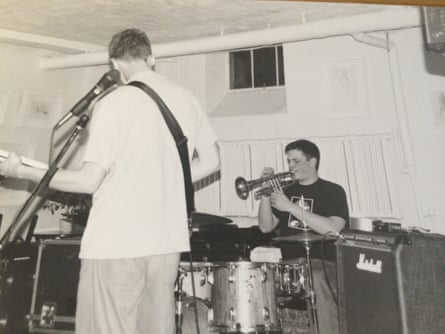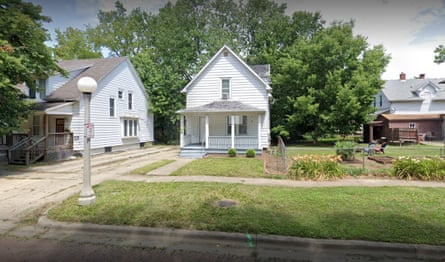American Football didn’t intend for a dilapidated student house in Urbana, Illinois to become a cult musical landmark. As with much of the band’s career, it just happened. They’d chosen the now iconic photo of the white-panelled building to feature on the cover of their 1999 self-titled album at random – it captured the vibe of the town they’d just finished college in and the photographer, also a student at the time, was cheap. But when the record unexpectedly caught on years later, 704 W High Street became an indie monument, prompting pilgrimages from fans across the world and warranting its own Wikipedia page. “It was just dumb luck,” says guitarist Steve Holmes, now 46. “It kind of took on a life of its own.”
So when rumours of its imminent demolition emerged last year, the band made a drunken pact with the label and original photographer to buy the house. “We were just joking, and then it sort of came together,” says vocalist Mike Kinsella, laughing. “I don’t know who, a week or two later, was like: shall we buy that house for real? Like, sober?” The sale went through last month.
The enduring appeal of the house is just one part of the mystery of the group, who made one album, quickly disbanded, and found fame in underground music circles years after they lost touch. What started as an offhand college project by three music nerds is now credited as the cornerstone of midwestern emo; with their winding instrumentals and affecting songs that naively wander around themes of teenage angst and heartbreak, it was a soft, nuanced alternative to the ultra-masc variations of rock at a time when nu-metal was wildly popular.
That first record, which has now racked up tens of millions of streams, also unknowingly laid the foundations for later iterations of the genre, from stadium-emo outfits like Paramore (they collaborated with frontwoman Hayley Williams in 2019) to its offshoots, including the current generation of emotionally literate singer-songwriters such as Snail Mail and Phoebe Bridgers. Matty Healy of the 1975 recently described American Football’s debut as a “really, really beautiful moment that stood outside of what was considered emo-rock and math-rock”, and American Football, touring the UK next week, support the 1975 at a huge outdoor concert in London on Sunday.
The band was formed in 1997 by Kinsella, Holmes and drummer Steve Lamos. They’d grown up in the suburbs together, where playing instruments and going to DIY shows in people’s homes was what they knew, and their university experience in Illinois followed in a similar vein. “This is the pre-internet era, so there’s literally nothing to do other than hang out with your friends and make music,” says Holmes, describing the blocks of student housing that surrounded them and the vast cornfields separating them from major cities. “There was a big Greek fraternity and sorority scene in Champaign but we were the opposite of that. We were the incredibly earnest, naive and nerdy kids on the other side of campus just listening to records.”
The trio would get together to practise on weeknights and weekends, with their schedule dictated by what shows were on TV. They’d spend hours looping long, intricate instrumentals from their sofas – a technique that was loosely driven by a desire to get better at their craft, but which went on to characterise their sound. “We didn’t write choruses or anything because we didn’t know how to write fuckin’ hits,” Kinsella says.
They knew there would be vocals of some kind, but the final lyrics came much later when their recording session was nearing. Pulled from Kinsella’s high school notepads on a whim, they appear to trace a series of endings: the demise of a relationship, the change of the seasons, perhaps the end of the night. On the opener Never Meant, he whispers about the “autumn night where we realised / We were falling out of love,” before expressing some kind of hope for “when the summer ends” in the following track. Despite the candour, his explanation two decades later is vague, an interesting contrast for someone credited as one of the touchstones of emo. “I had no actual experiences happening. Maybe [it’s about] the girl I broke up with in high school. It’s just like ‘meh, I’m a kid growing up’,” he says, nonchalantly. “Sad music is just what I was drawn to, and so when I had to sing, because these fuckers” – Kinsella gestures at his bandmates – “wouldn’t do it, I was just kinda like: ‘Well, what’s the point of music? It’s gotta be sad, right?’”

The prospect of making it as a band was bigger than their “little indie ambitions” could conceive: they only gave themselves a name so they could play at house parties their friends had organised. “No one cared about this band,” Holmes says. “We were an afterthought to an afterthought.” When I ask how many gigs they played together across their initial three-year history, they settle on something between eight and 15, mostly to no more than a dozen people.
The first album, now a beloved cultural artefact of that time, was recorded across three days in the garage of the only studio engineer they knew. It was a real DIY affair, with just a few live takes, no click track and faulty equipment. “The Dat would record to these VHS tapes and there was this constant fear that one or more things would get erased,” says Lamos. “At some point, something did.” With all three members fiddling with the mixing desk at once, he says the master tapes, which no longer exist, could not be replicated even if they tried.
It was the week after college ended and, at the time, the process didn’t feel like the significant moment it turned out to be. The record was released a few months later on CD and circulated locally via Champaign indie label Polyvinyl. “It’s not like there was a film crew documenting the making of the album,” says Kinsella. “We were just like: ‘Let’s record these songs because we’re never gonna play them again.’ And that was it, we documented the thing we made, and then we all moved on.”

Kinsella and Holmes left Urbana and got jobs, while Lamos stayed on to start a PhD. With all three wrapped up in work, marriage and parenthood over the subsequent years, they didn’t manage to maintain contact, save for the odd email or basketball game. It was only when Lamos was approached by a student in 2009 that they became aware of the band’s popularity on filesharing service Limewire. “I was floored,” he says.
After unearthing some early tape demos in 2014, they reconnected with Polyvinyl to work on a deluxe reissue of the record, prompting a string of reunion gigs in New York, with Mike’s cousin Nate Kinsella joining on bass. It was the first time Holmes had played in 15 years, and by far the biggest venues any of them had ever performed in. By the time the pandemic forced another break, they’d played about 120 shows across Asia, Europe and the US.
Growing older and becoming a father has made singing the original lyrics feel odd, says the 46-year-old Kinsella. Sometimes, he feels embarrassed and laughs to himself inside; at other times he feels melancholy. But it’s also recontextualised them: “Fatherhood shapes you in all kinds of ways,” he says. “The world isn’t mine any more and everything I was consumed with at 18 seems sort of small now.”
In order to express how they felt now as adults, and to escape being permanently boxed into “cover band” territory, American Football released a second album in 2016. The cover references the first with its interior shot of the same Illinois house, but the music stretches beyond, with additional instrumentation and a more optimistic, country-pop sensibility. Their third LP, released in 2019, pushed things further still with the addition of synthesisers and guest vocals. “We just kinda keep it open, like – what’s in the American Football world, and what can we add to it?” Nate explains. “How do we throw in some fun curveballs for fans who have been along for the ride without totally disappointing anybody?”
They also ditched the house on the cover, instead opting for a panned out image of the sky. “It’s bigger, it’s more ambitious,” Kinsella says. “It’s not about this one person’s little break up story, it’s more universal.”
Their current tour of the UK and US is the first time they’ve played together after a three-year hiatus and the prospect of performing to thousands of fans still baffles them. “When you’re up on a big stage looking out at a sea of people, I sometimes find myself laughing and thinking: this is absurd,” Holmes says. “Like, after this weekend, I’m gonna go back home to my [full-time] job and being bossed around by my 10-year-old to make him breakfast.”
While they feel the band are now more popular than they’ve ever been (“It seems like the less we do, the more people care about it,” Holmes laughs), their ambitions remain humble. “I don’t think any of us have any interest in forcing it on people,” says Kinsella. “We’re old enough and we have enough real life shit happening that we’re not under any illusion that this is gonna go somewhere.” It’s something the other members agree with. But with the band’s fortuitous record in mind, perhaps it will.

